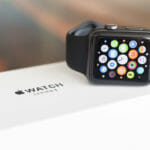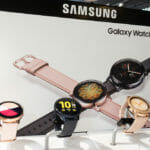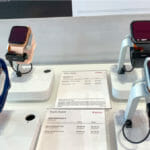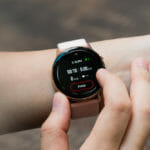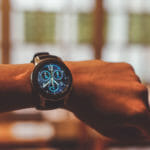When it comes to wearable technology, the choice is becoming endless. One of the biggest deal-breakers for some is the size of the watch. With an ever-growing catalog in Samsung’s set of wearables, it can be tough to narrow down your choice.

In this article, we will be chatting about the Samsung Galaxy Watch and comparing the 42mm model with its bigger brother the 46mm model. We’ve included a table for those who want the ‘at a glance’ comparison of the main features.
A Watch For All Seasons?
Even though the Samsung Galaxy Watch (see also ‘What’s The Difference Between The Samsung Galaxy Watch 3 Stainless Steel And Titanium?‘) has been superseded since its launch in 2018, we think that it’s still worth serious consideration. It’s still one of the most popular and polished smartwatches available today.
There are a few reasons why it still holds its own and makes for a strong competitor, namely an attractive design, solid user interface, and above all, incredible battery life.
The Differences (Or Lack Of) Between The 42mm And 46mm
It’s common for different models of the same device to have major differences. It’s almost become expected that this will happen in the tech industry.
However, when we look at the key differences between the Galaxy Watch 42mm and 46mm it’s noteworthy that there aren’t that many differences. Even when there are differences, these are only marginal. Overall, the experience is similar for either model.
One of the main differences between the two models (not including overall size) is the battery size, which almost seems like stating the obvious. As you might expect, the 42mm model has a smaller battery, which roughly translates to less time between charges.
The 46mm battery capacity is almost double that of the 42mm. So if that was our only point of comparison or the only aspect you might be interested in, the 46mm trumps the 42mm. That being said, there are noteworthy factors to consider outside of battery life.
The first of these is the overall size of both editions. The 46mm can feel like you’ve been tethered to a rock, especially if you wear it on consecutive days and overnight.
As expected, the 42mm is easier to wear for more people. Second on the list of factors is color choice. The 42mm has 2 color choices, one of which is rose gold, which we feel is a subtle hint that women to have smaller wrists might prefer the 42mm model.
In terms of technical features, the two models are identical. Within the casing of both models is the same memory, storage, processor, capabilities, and software. This most likely contributes to the battery longevity of the 46mm model, as the larger battery is powering the same internal specs.
As you might expect, they can both do things like track daily activity and fitness, monitor your heart rate and sleep pattern.
At A Glance Table
If you need a quick breakdown of the features of both the Galaxy Watch 42 and 46mm models we’ve included a handy table with the key features side by side below:
| Features | Galaxy Watch 42mm | Galaxy Watch 46mm |
| Battery | 270mAh | 472mAh |
| Display | 1.2 inch | 1.3 inch |
| Available Colors | Rose Gold, Black | Silver |
| Dimensions | 41.9 x 45.7 x 12.7mm | 46 x 49 x 13mm |
| Weight | 49g | 63g |
Pros And Cons Of The Galaxy Watch 42mm
Despite being smaller than the 46mm version, Samsung managed to get every single smartwatch feature inside the 42mm, whether magic was involved is up for debate.
Pros
- Does everything the 46mm version does
- Has multiple color options (Black and Rose Gold)
- Can fit a wider range of wrists
Cons
- Battery life isn’t the best, especially with an always-on watch face
Pros And Cons Of The Galaxy Watch 46mm
Owing to the larger size of the Galaxy Watch 46mm version it can feel on the heavier side when worn. The battery in the 46mm, as mentioned above, is nearly double the capacity of the 42mm meaning this thing has the potential to last you up for 4 days until it needs charging.
Pros
Incredible battery life for a smartwatch
Larger display
Cons
Only one color is available
Too big for some wrists
Wrapping Up
If a slightly chunky design, particularly on the 46mm model, isn’t an offputting aspect of wearables for you then the Galaxy Watch is a solid contender for your cash.
The operating system on the Galaxy Watch is one of the smoothest we’ve used in smartwatches of the same category. Unlike its competitors, the Galaxy Watch looks like a watch which only adds to the overall charm of this smartwatch.
The Galaxy Watch 42mm fits most wrist sizes including men and women. It can do everything its bigger brother can, just with less time between each charge. In our opinion, it’s a strong all-rounder.
If wrist size isn’t something you are concerned about, the Galaxy Watch 46mm is a no-brainer. Especially if you’re a Samsung/Android user already, this watch makes the perfect companion to your existing tech.
The bigger battery life is a real talking point in the Galaxy Watch 46mm as it is genuinely impressive. On some tests, the battery lasted four days with no real problems, even going into a fifth day on the low power mode.
- How to connect Bluetooth headphones to a Chromebook Without Summoning Tech Support - December 15, 2025
- Best Fitness Trackers for EMS Workers: Because Your Heart Rate Isn’t the Only Thing Racing - December 15, 2025
- Why do my Bluetooth headphones not skip tracks? Tech tantrums and other musical mysteries - December 14, 2025

